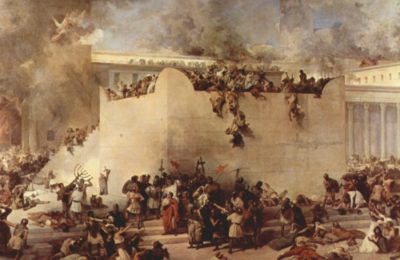With Tisha b’Av around the corner, we find ourselves nearing the end of the Three Weeks, a period of national mourning for the Jewish community bookended by two fast days: the 17th of Tammuz and 9th of Av. Throughout these three weeks, we’re meant to abstain from celebrations — hence our article last week about how some Orthodox Jews stayed away from musical fireworks shows on the 4th. You may have also noticed that wedding invites have been sparse!
The origin of this time being designated for mourning is traced all the way back to the destruction of the First Temple, which happened in 423 BCE. Even with this original event, however, there is disagreement about the actual date. Biblical sources have the destruction happening either on the 7th (Kings) or 10th (Jeremiah), while the Talmud says the destruction began on the 7th but the Temple only began burning on the 9th and continued into the 10th. Classic Jewish polemics, right?
Tradition, rabbinic literature and, frankly, sometimes legend has it that many of the tragic events that have befallen the Jewish people took place during these three weeks. Another interpretation says that even when momentous events did not happen on Tisha b’Av itself, or even during the Three Weeks, the origin of the tragedy can be traced to this three-week period.
One example of such an event can be found on Page 5 of this week’s IJN. In an essay on World War I, Larry Domnitch writes that Germany declared war on Russia on Tisha b’Av 1914, an act that — ultimately — led to the genocide of European Jewry.
While we can’t argue with Domnitch’s conclusion that WW I was a harbinger of the Holocaust, we have a slight problem with the emphasis on Tisha b’Av. You see, though Germany did declare war on August 1, 1914, which that year coincided with Tisha b’Av, World War I actually began on July 28, 1914, when Austria-Hungary declared war on Serbia.
So how far back do we trace? To the origin, or to the event that coincides with Tisha b’Av?
The inception of WW I is normally traced to the assassination of Archduke Franz Ferdinand on June 28, 1914, a date that was neither on Tisha b’Av, nor on 17 Tammuz, or any date in between. The War could also be traced to any other number of events cited as causes. Though Dominitich does an effective job of demonstrating why it was Germany’s engagement in the war that spelled disaster for Europe’s Jews, Germany’s involvement predated its declaration, and could be traced to July 24, when the Kaiser declared unconditional support for Austria.
Another problem with this “tracing back” approach, is that we mark the two fast days of 17 Tammuz and 9 Av because of the destruction that took place on those particular days, not because of the events that led to the destruction of the Temples.
In our research we did come across several other events that took place on 17 Tammuz itself, such as the liquidation of the Kovno Ghetto (July 8, 1944). But what about the other ghetto liquidations? Are they less tragic or monumental because they didn’t happen during the Three Weeks?
Why the need to fit everything neatly into a time slot? As we all unfortunately know from our own lives, tragedy strikes indiscriminately. That unpredictability is in fact why tragedies are so traumatic. The Three Weeks, and Tisha b’Av in particular, are incredibly important, as they provide our community with an opportunity for collective mourning and remembrance. But that doesn’t mean that we mourn only the events that took place during this time period, and it shouldn’t mean that we must uncover a connection between every tragedy and this time period.
Regardless, though, of when a tragedy hit, Tisha b’Av is an ideal opportunity to remember and reflect.












